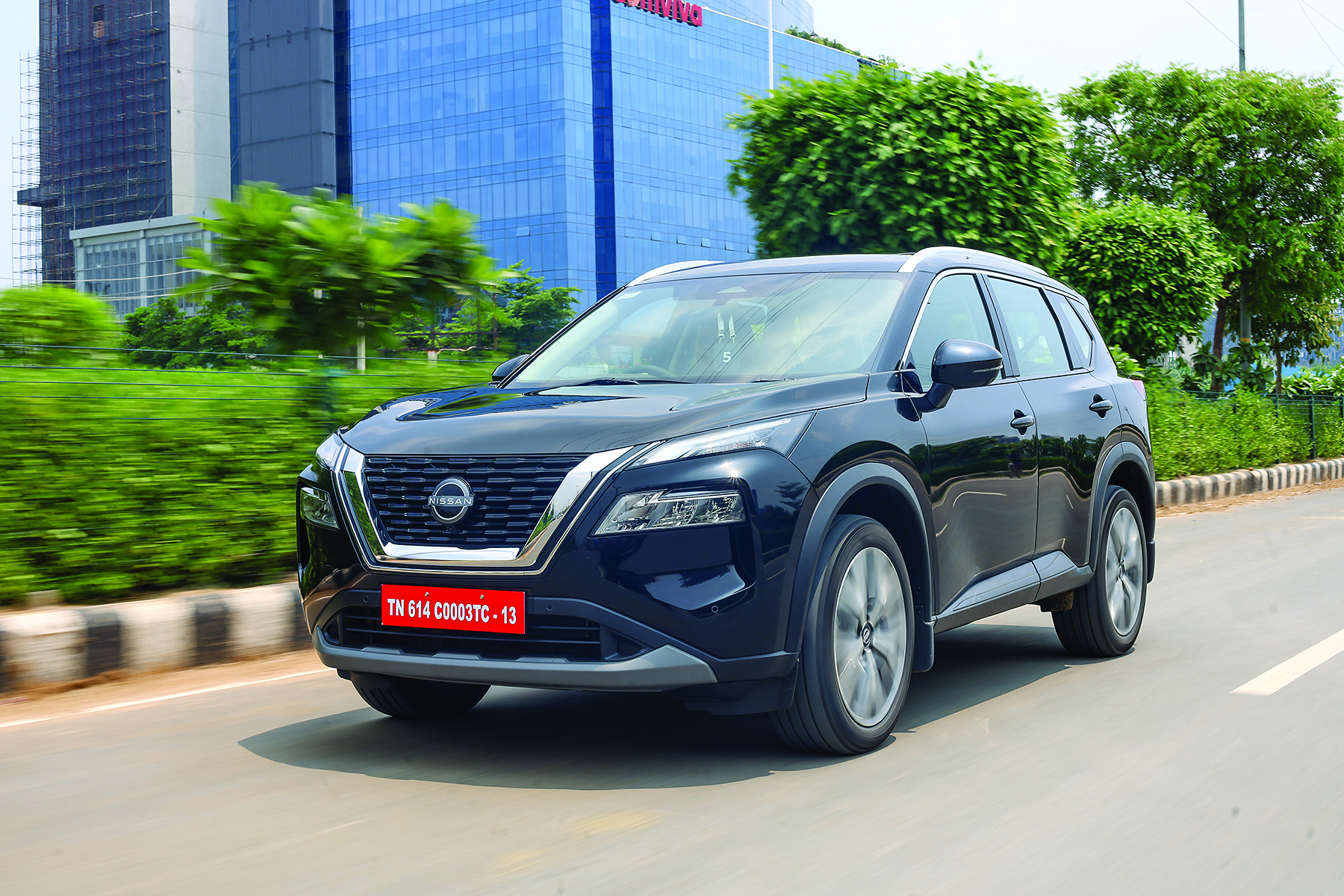Nissan has chosen a 2WD variant of the X-Trail for their re-entry into the premium segment. We drove it for a day to find out if it’s good enough for the task!
“I want to drive your Jonga, Shiraz,” said a fellow auto journalist, during a casual office banter. This was in 2010, but, irrespective of the period, this kind of a question, by a colleague, is a fair ask, right? Absolutely. The issue is, I never owned a Jonga. I own a flat-fender Jeep, a left-hand-drive Willys CJ-3B to be precise, which doesn’t look anything like a Jonga. I did correct him, but, as is the norm with most people in their early twenties today, who lack the art of acknowledging their blunders with grace, the situation wasn’t any different back then too. As such, he shrugged it off with sheer disdain. Therefore, I had to stop myself from further educating him that not only are the Jonga and Jeep two different vehicles, the former is actually a Nissan Patrol P60…
Fast forward to 2024, and not much has changed. I still see car blogs mixing up Jonga, Jeep and Nissan 4W73 (aka the Nissan One Ton) in their daily news articles.
The point is, if the majority of Indian auto journalists do not know the difference between a Jeep, Jonga, and One Ton, and also that the Jonga is actually a Nissan, can you really expect the masses to be any wiser? Of course, there are hardcore offroad enthusiasts (such as yours truly) who know, but the masses don’t. And Nissan India is missing out capitalising on the popularity of the Jonga by not telling the masses that the Magnite is made by the same company that produced the Patrol P60. In fact, the company should ideally have a fully restored specimen in at least one of their showrooms, and it will give them the sort of branding even the GTR couldn’t manage. Also, they should’ve ideally gotten their flagship Patrol here, especially considering that all its competitors (LC300, LX500D, etc.) are already here and their entire lots get sold out in a couple of weeks. That said, the X-Trail (also called the Rogue in some markets) has lately been the highest selling Nissan model globally, so I can’t really blame them for choosing it as the first CBU this year. Also, while other journalists drove it for less than 80 km, I managed to clock around 200 km in the same duration to see what it promises.
DESIGN And ROAD PRESENCE
This is the latest, 4th generation, X-Trail, which thankfully looks more like the flagship Patrol than any of the X-Trail models ever did. And that’s a good thing, considering the popularity all Patrol models have in India.
Therefore, the X-Trail looks big and imposing, but without getting too boxy to hurt Gen Z and millennial sensibilities.
I also love the fact that Nissan India chose to bring the X-Trail here with 20-inch wheels.They look fabulous and make it stand out from its competitors. There’s really nothing in the segment that even comes close to it in this department.
Overall, it’s a handsome SUV, which might not make heads turn (no vehicle in this segment is a head-turner anyway), but surely does command a fair bit of respect on our roads. That’s saying something when you live in the NCR.
INTERIORS
This is where Nissan India might run into a problem, at least initially. See, one of the perils of entering a market late is that you have to sometimes unwillingly conform to the trend to be accepted. You can’t expect the buyers’ taste to change overnight. Therefore, for now at least, even though the cabin is totally sorted, both ergonomically and qualitatively, it might not be “perceived” as “luxurious” in the face of the competition that has made people too accustomed to stuff like leather upholstery, powered seats, electric tailgate, etc. Again, no one would have any complaints whatsoever regarding the quality of materials used, or with the fit and finish of any part, inside the cabin; it’s just that the overall ambience isn’t “conventionally premium” or posh. This cabin would only be appreciated by those with an evolved sense of aesthetics…
However, there’s one thing that would be unanimously appreciated by all—its bone-chilling air-conditioning. This is where the Nissan X-Trail beats every other SUV in its segment, and, no, contrary to what most reviewers would tell you, the Fortuner isn’t from this segment. The Tucson, Kodiaq, and Tiguan, comprise the X-Trail’s primary list of competitors, whereas the secondary list would include the C5, Compass, and Meridian. The X-Trail, if priced well, could tempt buyers of the Hycross and XUV700 as well…
A sliding second row of seats is another thing not present in the majority of X-Trail’s competiton. As such, even with two six-footers in the front seats, you can still enjoy the best-in-segment legroom in the second row. The third row is pretty much useless, and even Nissan isn’t calling it a full-fledged 7-seater, but a 5+2, with those “2” being kids, that too not your own. Preferably. However, I wish the second row seat squabs were bigger. Their current size isn’t big enough to keep those with thundering thighs as happy as some of the X-Trail’s competitors can.
The front seats are perfect, but Nissan should have at least made the height adjustment electric. I am okay with the manual adjustment for sliding the seat, but operating the seat height adjustment lever like a rural pitcher-handpump doesn’t make for a dignified sight in a vehicle of this segment. The silver lining is the provision of electric adjustment for lumbar support.
ENGINEERING | VARIABLE COMPRESSION RATIO TECHNOLOGY
This is where Nissan has shut the naysayers up completely. All auto journalists, YouTubers, and their uncles, had ridiculed Nissan upon getting to know that the X-Trail would come here with a 1.5 L three-cylinder petrol engine. Now, after driving the vehicle, everyone is all praises about this engine, and, this time, not without reason.
See, this engine gets the same variable compression ratio tech that Nissan had first put in the Infiniti QX50, in 2018, after around two decades of R&D. This technology essentially allows Nissan to make the compression ratio—which has always been a fixed number (different for different engines, but fixed) in internal combustion engines—variable. It achieves this by varying the distance between the piston top (TDC, or the Top Dead Center) and cylinder head. Yamaha RD350 enthusiasts would understand this even better as, among other things, shaving some metal off the cylinder head to reduce the squish gap, without sending the spark plug into oblivion, has always been their holy grail for increasing performance. But, those again yielded fixed numbers, obviously. Here, Nissan varies the length of piston travel to vary the compression ratio between 8:1 to 14:1, and it does so by using linkages starting from the con-rod end towards the crankshaft, and even past the crankshaft assembly, where you’ll also see a harmonic drive (an electric motor, essentially), actuator, control shaft, and a few more linkages. So, yes, instead of a simple piston, con-rod, and crankshaft assembly, this engine has a way more complex assortment of parts…
But, what’s in it for you? A lot. More performance when you need it, and good fuel efficiency when you’re going easy on the throttle. That sounds like a conventional engine, then, right? Well, yes; however, both the performance and fuel efficiency figures are a shade better than conventional engines of similar displacement. The more important gains have been in vibration reduction, as secondary imbalances have been almost completely eliminated. Also, since the con-rod movement path in the combustion stroke is almost straight, it reduces the amount of lateral force exerted by the piston on the cylinder wall.
And if you thought that was all, wait, there’s more. The engine has also been programmed
to switch over to the Atkinson combustion cycle to aid in altering the compression AND expansion ratios. Plus, this engine uses both port and direct injection for optimal combustion in low-load scenarios, while switching over to direct injection completely in high-load situations. I think I again heard you asking, “what’s in it for me?”
Simply put, you get a powerful, fuel efficient, and smooth engine, which will also be relatively silent, and won’t heat as much as most other conventional engines of the same size do in our conditions.
ENGINE & GEARBOX PERFORMANCE
Now while the specsheet might only say 163 PS, I achieved a 0–100 km/h (speedo) time of 9.2 seconds. This was with the AC on and with a co-passenger. For reference, I had managed an 8.6 s (GPS) run in the 200 PS XUV700 petrol AT in winters (with the AC off, obviously) and with just me in the vehicle. I reckon this X-Trail to seriously worry the XUV700 on a drag strip…
The CVT is also a peach. It has zilch rubberband effect, and behaves like a good accommodating friend in all conditions. I already told you about its fantastic acceleration, and I am also happy to report that overtaking maneuvers are almost as energetic. The cherry on top would be its stressfree cruising characteristics—100 km/h comes up at well under 2,000 rpm, and it’s quite silent at these speeds, although you do hear a bit of wind and tyre noise.
FUEL EFFICIENCY
One cannot comment on the fuel efficiency during first drives, especially when you’ve driven pedal to metal most of the time. Still, I will stick my neck out and say that this can return 8–10 km/l in the city, and 12–14 km/l on the highways provided you drive with a light right foot.
RIDE QUALITY AND HANDLING
The suspension with only two people onboard felt a bit firm initially, but it still did perform well on bad roads. For perspective, the X-Trail is a shade better on bad roads than the Hyundai Tucson, and the same can be said about its handling.
VERDICT
While most are still saying that although this is a good vehicle, Nissan should have gotten the e-power (hybrid) X-Trail. I disagree. Nissan should’ve ideally brought their conventional 2.5 L naturally aspirated AWD X-Trail. That said, even this one isn’t bad at all. It has all the power you expect from a vehicle of this size; all the ground clearance (210 mm) you expect from a vehicle of this size, and even though it isn’t an AWD, it happens to be the only FWD SUV in India to have a BLD (Brake Lock Differential), which makes it more capable off the road than the 2WD variants of its competitors. This could be a winner for Nissan IF they price it right. I know it would be a challenge because it’s a CBU, but if they somehow manage to undercut the competition, even by a wee bit, it would work massively in Nissan’s favour. Fingers crossed.























